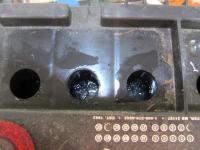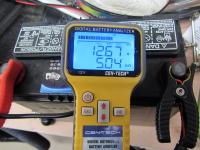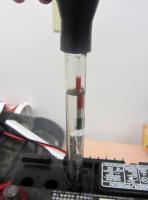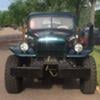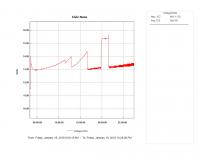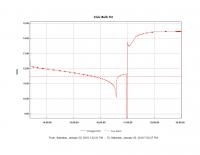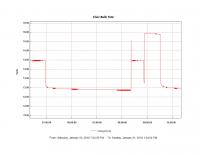(Warning-- wall of text ahead. If you're not into batteries and battery charging, you may want to skip this one!)
Last week my wife called from the retirement community where her Mom lives to tell me her Mom's car wouldn't start. That got me into a frozen-battery situation and I encountered some things I've not seen before.
SUMMARY-- Battery froze. My efforts to get it back to normal failed but old-school method by battery shop appears to have worked.
DETAIL --
First, I came close to trying to jump-start a frozen battery. I didn't know it was frozen at the time. But the only thing that stopped me from the jump-start attempt was learning there was no place for me to move the car within reach of an electrical outlet for my charger (there at the facility). I wasn't too keen about leaving my charger there anyway so I decided to pull the battery and take it home.
I took the battery into my workshop and prepared to charge. I checked temperature at a post and several places on the case and it was now 47F. But when I opened up the maintenance caps this is what I saw:
(click to enlarge)
The battery temperature externally was 47 at this point but apparently the battery froze in the single-digit and below-zero temperatures we've had here in the last few weeks.
I allowed the battery to thaw until the next day and then tested both with the voltmeter and hydrometer. The voltmeter said 11.5 volts and the hydrometer was far into the red at 1105-1110.
I charged the battery using my new Noco G7200 charger. After a rest the battery showed 12.6 volts and passed a load test. Good to go, right? But then I tested with the hydrometer. Still a deady-dead-dead 1105. Wut? Isn't the hydrometer supposed to be the most accurate measure of a battery's state of charge?
After a bit of reading I decided the battery must be stratified. I've not seen this before but it's situation where the electrolyte concentrates at the bottom of the battery. It happens when a battery-- particularly a flooded-lead-acid one --- sits discharged for a long time and/or doesn't get charged properly due to shallow discharge/charge cycles.
I thought of just putting the battery back in service but was afraid that upper layer would just freeze again.
So at this point I had a fully-charged battery according to the charger. I then put it in Repair Mode. That's supposed to now charge at a relatively high voltage (between 15 and 16 volts) in an 'equalization' process. And it's one of the recommended ways to deal with stratification.
According to the hydrometer, the G7200's Repair Mode did nothing whatsoever (or at least nothing discernable).
I then decided to try my Ctek charger's Recondition mode. The manual for that one specifically says it addresses stratification. But I didn't want to just do another high-voltage process on top of the last one. So I discharged the battery to a bit under 12 volts with a small inverter and a 60-watt incandescent lamp, then let the Ctek charge it fully before putting it into Recondition mode. During that process, I saw bubbles for the first time. Just a few of them but the bubbles gave me hope that de-stratification was happening.
And after the process the hydrometer moved for the first time. But it only went up into the middle of the red at 1160-1170.
So at that point here's where I was...
(click to enlarge)
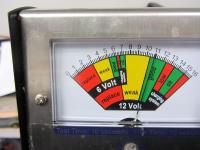 (at end of 15-second 130-amp test)
(at end of 15-second 130-amp test)
At that point I figured I'd take it back to Battery Warehouse where I bought it and see if that guy's tests showed the same thing. Results were the same-- good voltage, passes load test, hydrometer says battery is near dead.
The guy told me the battery needed a good charge with an old-school battery charger. He asked if I had one of the older-generation chargers, typically one with something like a 10-amp / 3-amp switch and maybe a 6/12 volt switch and an ammeter. I do but I was already there so took him up on his offer to charge it there in the shop.
I went into the shop two days later to pick up the battery and it now, for the first time, had a normal hydrometer reading. In fact it was so good I asked the guy if he had done anything other than charge it (thinking he may have added acid). He said no.
By way of explanation, he said he thought the smart-chargers only put a 'surface charge' on the battery. I can't say I agree but I have seen smart-chargers fooled at times. I also have to wonder if I've been fooled by the whole chain of events and the passage of time making the difference, rather than just the charge with the old-school charger.
At this point I don't know how badly the one-year-old battery was damaged by the freezing incident. One school of thought is the concentrated acid below the top of the plates isn't freezing. It's just the water at the top (because freezing is a function of electrolyte concentration). The problem, though, is I don't know how far down into the plates the freezing goes. Which kind of turns it into a charge-it-and-see-what-happens thing.
TAKEAWAYS-
- Batteries can and do freeze in +10 to - 10 temperatures (when they're in a state of discharge).
- If I find I have a discharged battery in temperatures below freezing, I should consider treating it as a frozen battery instead of just going ahead and jumping it or charging it.
- I can look into an FLA battery to see if the electrolyte is frozen but I don't know how to go about it for an AGM battery. One would think you could just check temperature of the case with a temp-gun but that didn't even come close to working for me. In fact, when I shot the temperature of the ice (!) in through the maintenance holes, I had a difficult time getting the gun to read a temperature even close to freezing.
- It would be helpful to have an idea of when to be concerned about possible battery freezing. I just found a table in a Trojan Batteries White Paper on storing deep cycle batteries. It doesn't account for possible stratification but at least it gives us some idea of specific gravity readings and state-of-charge readings related to temperature.
Column headings are Specific Gravity, State of Charge, Freezing Temperature...
1.280 100 -92.0 °F
1.265 92 -71.3 °F
1.250 85 -62.0 °F
1.200 62 -16.0 °F
1.150 40 + 5.0 °F
1.100 20 +19.0 °F
(Source: BCI Battery Service Manual © 1995 T)
- A battery that tests dead with a hydrometer may be stratified.
.




